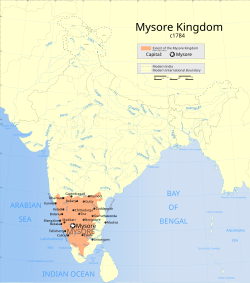
Back مملكة ميسور Arabic Maysur əmirliyi Azerbaijani میسور شاهلیغی AZB Майсор Bulgarian मैसूर राज Bihari মহীশূর রাজ্য Bengali/Bangla Rouantelezh Maisor Breton Regne de Mysore Catalan Maisúrské království Czech Kongeriget Mysore Danish
Kingdom of Mysore | |||||||||
|---|---|---|---|---|---|---|---|---|---|
| 1399–1950 | |||||||||
 The Kingdom of Mysore at its greatest extent in 1784 under Tipu Sultan | |||||||||
| Status | Kingdom (Subordinate to Vijayanagara Empire until 1565) under a subsidiary alliance with the India Office and British Crown from 1799 Princely state under the India Office and British Crown from 1831 | ||||||||
| Capital | Mysore, Srirangapatna, Bangalore | ||||||||
| Largest city | Bangalore | ||||||||
| Official languages |
| ||||||||
| Religion | Hinduism, Islam, Christianity | ||||||||
| Demonym(s) | Mysorean | ||||||||
| Government | Monarchy | ||||||||
| Maharaja | |||||||||
• 1399–1423 (first) | Yaduraya Wodeyar | ||||||||
• 1940–1950 (last) | Jayachamaraja Wodeyar | ||||||||
• 1761-1782 | Hyder Ali | ||||||||
• 1782-1799 | Tipu Sultan | ||||||||
| Dewan | |||||||||
• 1782–1811 (first) | Purnaiah | ||||||||
• 1946–1949 (last) | Arcot Ramasamy Mudaliar | ||||||||
• 1926-1941 | Mirza Ismail | ||||||||
| History | |||||||||
• Established | 1399 | ||||||||
• Earliest records | 1551 | ||||||||
| 1767–1799 | |||||||||
| 1759–1787 | |||||||||
| 1950 | |||||||||
| |||||||||
| Today part of | India | ||||||||
The Kingdom of Mysore was a geopolitical realm in southern India founded in around 1399[3] in the vicinity of the modern-day city of Mysore and prevailed until 1950. The territorial boundaries and the form of government transmuted substantially throughout the kingdom's lifetime. While originally a feudal vassal under the Vijayanagara Empire, it became a princely state in British Raj from 1799 to 1947, marked in-between by major political changes.
The kingdom, which was founded and ruled for the most part by the Wadiyars, initially served as a feudal vassal under the Vijayanagara Empire.[4] With the gradual decline of the Empire, the 16th-century Timmaraja Wodeyar II declared independence from it. The 17th century saw a steady expansion of its territory and, during the rules of Narasaraja Wodeyar I and Devaraja Wodeyar II, the kingdom annexed large expanses of what is now southern Karnataka and parts of Tamil Nadu, becoming a formidable power in the Deccan.
During a brief Muslim rule from 1761 to 1799, the kingdom became a sultanate under Hyder Ali and Tipu, often referring to it as Sultanat-e-Khudadad (transl. God gifted empire).[5][6] During this time, it came into conflict with the Maratha Confederacy, the Nizam of Hyderabad, the Kingdom of Travancore, and the British, culminating in four Anglo-Mysore Wars. Mysore's success in the First Anglo-Mysore war and a stalemate in the Second were followed by defeats in the Third and the Fourth. Following Tipu's death in the Fourth War during the Siege of Seringapatam, large parts of his kingdom were annexed by the British, which signalled the end of a period of Tipu over South India. Power returned absolutely to the Wadiyars when Krishnaraja Wodeyar III became king.
In 1831, the British took direct control of the kingdom and a commission administered it until 1881.[7] Through an instrument of rendition, power was once again transferred to the Wadiyars in 1881, when Chamaraja Wadiyar X was made king. In 1913, in lieu of the instrument, a proper subsidiary alliance was struck with the kingdom during Maharaja Krishnaraja Wadiyar IV.
Upon India's independence from the Crown rule in 1947, the Kingdom of Mysore was ceded to the Union of India. Upon accession, it became Mysore State, later uniting with other Kannada speaking regions to form the present-day Karnataka state. Soon after Independence, Maharaja Jayachamaraja Wadiyar was made Rajapramukh until 1956, when he became the first governor of the enlarged state.
Even as a princely state, Mysore came to be counted among the more developed and urbanised regions of South Asia. The period since the penultimate restoration (1799–1947) also saw Mysore emerge as one of the important centres of art and culture in India. The maharajas of Mysore were not only accomplished exponents of the fine arts and men of letters, they were enthusiastic patrons as well. Their legacies continue to influence music and the arts even today, as well as rocket science with the use of Mysorean rockets.[8]
- ^ "Kayou Shri Gowri Anthem". 30 August 2015.
- ^ Subrahmanyam, Sanjay (2017). Europe's India: Words, People, Empires, 1500–1800. Harvard University Press. ISBN 9780674977556.
- ^ Lethbridge, Sir Roper (1893). The Golden Book of India: A Genealogical and Biographical Dictionary of the Ruling Princes, Chiefs, Nobles, and Other Personages, Titled Or Decorated, of the Indian Empire. Macmillan. p. 362.
- ^ "Raja Wodeyar's Conquest of Srirangapatna". 26 March 2018. Archived from the original on 6 December 2022. Retrieved 6 December 2022.
- ^ Yazdani, Kaveh (2017), India, Modernity and the Great Divergence: Mysore and Gujarat (17th to 19th C.), Brill Publisher, p. 115, ISBN 9789004330795
- ^ Simmons, Caleb (2020), Devotional Sovereignty: Kingship and Religion in India, Oxford University Press, pp. 10–12, ISBN 9780190088897
- ^ Rajakaryaprasakta Rao Bahadur (1936), pg. 383
- ^ Roddam Narasimha (May 1985). Rockets in Mysore and Britain, 1750–1850 A.D. Archived 27 September 2007 at the Wayback Machine. Published by the National Aeronautical Laboratory.
Cite error: There are <ref group=lower-alpha> tags or {{efn}} templates on this page, but the references will not show without a {{reflist|group=lower-alpha}} template or {{notelist}} template (see the help page).

